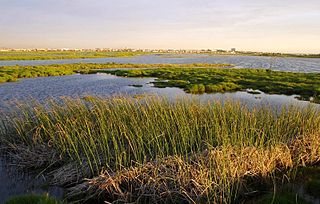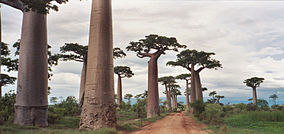
The Ribble and Alt Estuaries lie on the Irish Sea coast of the ceremonial counties of Lancashire and Merseyside in the traditional county of Lancashire in north-west England, and form the boundaries of a number of conservation schemes.

Ankarafantsika National Park is a national park near Andranofasika in the Boeny Region of Madagascar. The closest city is Majunga 115 kilometres (71 mi) north of the park. Ankarafantsika is mostly tropical in climate type. The Sakalava people are the predominant ethnic group living and farming here. The greater big-footed mouse lives in the park and is not known anywhere else.

Menabe is a region in western Madagascar, with its capital at Morondava. It covers an area of 46,121 square kilometres, and its population was 700,577 in 2018. The population mostly belongs to the Sakalava ethnic group. The region is named after the 18th-century Sakalava Kingdom of Menabe. The name "Menabe", in turn, means "big red", after the color of laterite rock that dominates the landscape.

Lagoa do Peixe National Park is a national park in the state of Rio Grande do Sul, Brazil. It was created in 1986 to protect a wintering zone for migratory birds along the Lagoa dos Patos, the estuary of the Guaiba river or Guaíba Lake about 200 kilometres (120 mi) south of Porto Alegre.

The Madagascar plover, also known as the black-banded plover, is a small monogamous shorebird in the family Charadriidae, native to western Madagascar. It inhabits shores of lagoons, coastal grasslands, and breeds in salt marshes. These plovers mainly nest in open grassland and dry mudflats surrounding alkaline lakes. The species is classified as vulnerable by the IUCN because of its low breeding success, slow reproductive rate, and weak adaptation to increasing habitat loss, leading to declining population numbers.

The Sakalava rail is a species of bird in the family Rallidae. It is endemic to western Madagascar. This bird is small with brown upperpart feathers, grey underparts, a yellow bill and red legs.

Cananéia-Iguape-Peruíbe Environmental Protection Area is a protected area in the State of São Paulo, Brazil. It has been designated as a Ramsar site since 2017.

The Kirindy Mitea National Park is a national park on the coast of the Mozambique Channel, in south-west Madagascar. The 72,200 hectares park contains many endemic animals and plants and claims to have the greatest density of primates in the world.

Tsimanampetsotsa National Park also spelt Tsimanampetsotse, and known as Tsimanampetsotsa Nature Reserve is a 432 km2 national park on the south-west coast of Madagascar in the region Atsimo-Andrefana. The park is 90 kilometres (56 mi) south of Toliara and 950 kilometres (590 mi) south of the capital, Antananarivo. Route Nationales (RN) 10 to Faux Cap passes the park and the nearest airport is at Toliara. The national park contains and is named after Lake Tsimanampetsotsa.
Bemarivo Reserve is a wildlife reserve in the north-west of Madagascar. It was created in 1956 and covers an area of 12,080 hectares. The reserve is known for its fauna especially endemic birds.

Bao BolongWetland Reserve is a national park in The Gambia. Established in 1996 it covers 220 square kilometres.

Odisha, one of the 28 states of India, has two basic kinds of forest: in the northeast region of the state the forest is classified as the tropical-moist-deciduous type, blanketing hills, plateaus and other high-altitude isolated areas; in the southwest the tropical-dry-deciduous variety dominate.

The Rietvlei Wetland Reserve is a 663-hectare (1,640-acre) nature reserve situated in Table View, Western Cape, South Africa. It is managed by the City of Cape Town's Environmental Resource Management Department.

The Tsiribihina is a river of western Madagascar.

The Madagascar succulent woodlands are a xeric shrublands ecoregion in southwestern and central western Madagascar. Native plants survive in the arid climate and long dry season with adaptations like succulent leaves, water storing trunks, photosynthetic stems, and dropping leaves during the dry season. The ecoregion is threatened by various human activities.
















